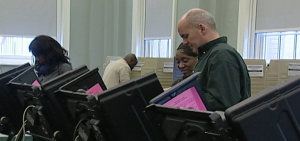News
Some Ohio voters who think they are independent might be shocked to learn they are not
By: Jo Ingles | Statehouse News Bureau
Posted on:
COLUMBUS, Ohio (Statehouse News Bureau) — If you ask people what their party affiliation is, they might tell you they are an independent or unaffiliated voter but that might not be true in some cases.

Unlike some other states where voters declare their party affiliation when they register to vote, under Ohio law, the only way you can declare your party affiliation is by voting in a party’s primary.
Secretary of State Frank LaRose, a Republican, explained if you voted on May 3, and requested a party’s ballot, you are considered a member of that party.
“If you voted in a Republican primary, you have declared your party affiliation as Republican. If you voted in the Democratic primary then you declared your party affiliation as Democrat,” said LaRose.
There are true independents or unaffiliated voters out there. In fact, most Ohio voters are. The latest numbers on the Secretary of State Website (as of October 10, 2021) show there are 7,982,501 registered voters and 6,196,547 of them are unaffiliated. There are 947,027 voters listed as Democrats, and 836,080 voters listed as Republicans and 2,847 are shown as being Libertarians.
It’s important to note this May 3 primary was a low turnout election. The unofficial numbers show 20.64% of the registered voters in Ohio cast a ballot in that election. It’s the third lowest turnout for an election since 1986.
There wasn’t a Libertarian party primary and there wasn’t a statewide ballot issue. So many independents had no way to vote because, unless they had a local issue at stake, they couldn’t cast an issues-only ballot. Most areas of the state did not have local issues on the ballot.
Twice as many Republican ballots were cast in the May 3 election as compared to Democratic ones. There could be several reasons for that, including the fact that there was a lot of excitement for a hotly-contested U.S. Senate primary among seven Republican candidates as well as Gov. Mike DeWine facing three GOP challengers.
So, how can I change my party affiliation?
Ohio voters who cast ballots in the May primary, aligning themselves with a party they don’t want to be affiliated with, might be able to change that later this summer. Ohio’s state legislative district maps — Ohio House and Ohio Senate districts — have been tied up in a battle for months, making it impossible to put Ohio House and Ohio Senate races on the May 3 ballot.
LaRose said he anticipates Ohio lawmakers will pass legislation soon that will allow voters to cast ballots for those contests on August 2. Voters who want to switch party affiliation can do that in August by taking a ballot for the opposite party. LaRose says his own mom might consider that.
“My mom is a lifelong Democrat but because her son was on the ballot, she decided to vote in the Republican primary so she’s listed as a Republican under Ohio law right now. I don’t know how my mom will choose to vote in the August 2 primary but if she takes a Democratic ballot, then she will be listed as a Democrat once again,” LaRose said.
For Ohio voters who cast a party ballot in the May primary and want to be aligned with unaffiliated or independent voters, it’s likely going to take a little longer.
“There’s a period of time that would have to elapse for them and if they don’t vote in a primary for a period of time, then they will be listed as unaffiliated. Or if they choose an issues only ballot, that could affect that as well,” LaRose said.
That period of time LaRose is talking about is two years. A statewide ballot issue isn’t planned for the August ballot either. So, most voters will not have access to an issues-only ballot this August unless they have local issues to vote on. Those include measures like school levies, library and park issues, or local liquor options.
All registered Ohio voters, regardless of party affiliation, can cast ballots this fall in the General Election. Ohioans will be able to vote for all statewide offices as well as some highly contested Ohio Supreme Court races and contests for the Ohio House and Ohio Senate.
9(MDU1ODUxOTA3MDE2MDQwNjY2NjEyM2Q3ZA000))

